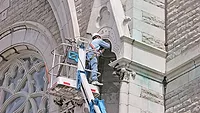From Landmark to Living Room: 3 Considerations for Historic Home Conversion

Photo credit: sturti / iStock / Getty Images Plus via Getty Images
Converting a historic building into a residential property is a growing trend in the real estate industry. R&R professionals are buying up old and abandoned lots and bringing them back to life, providing local residents with affordable housing while maintaining the classic architecture from past generations.
Any R&R company that wants to pursue historic building restoration should keep these three considerations in mind to ensure a successful project.
1. Determine the Necessary Treatment
The first step in any historic restoration is determining the level of treatment the building requires. Some buildings might need a simple facelift while others must be completely gutted. The following are four general types of treatment a building might need:
- Preservation: The first level of treatment is a simple preservation of the existing design with minor repairs and replacements to the interior. The building’s function remains the same.
- Rehabilitation: The second level is a rehabilitation of the building to fulfill a new purpose, also known as “upcycling” or “adaptive reuse.” However, it must retain its original character and integrity.
- Restoration: The third level is a complete restoration that removes any features that were added to the building’s original design during previous remodeling projects. The building returns to its earliest state, but it can now serve a new purpose.
- Reconstruction: The fourth level is a reconstruction of the building’s old parts that have not survived through the years, either from deterioration or from demolition. The building returns to its original form with a new lease on life.
Converting a historic building into a new residential complex usually falls under the rehabilitation category. For example, different R&R pros in Chicago have converted 20 abandoned school buildings into luxury condominiums, affordable apartments, community centers and public housing offices,1 they had to make extensive interior changes, but the facades remain largely intact.
Sometimes a restoration or reconstruction project is the necessary approach. A great example is the award-winning historic building that served as the home of the Daily News and National Enquirer in New York City. Contractors had to turn office space into apartment units, and the brown brick façade now has wider windows to attract residents.2
2. Preserve the Exterior Style
Although some façade adjustments may be necessary, the goal of a historic home conversion is to preserve its exterior style as much as possible. Finding the balance between tradition and innovation is challenging, but there are some time-tested techniques to make it work.
Here are some examples in key areas of the exterior:
- Woodwork: Focus on removing rotted and infested parts, use handheld tools to recreate original carvings and treat the wood with older staining solutions instead of new ones.
- Masonry: Use traditional repair techniques such as lime mortar rendering, use the same stones to match the original design and perform precision cutting with lasers and handheld tools.
- Roofing: Use older roofing materials such as slate and clay tiles on the outside, but install modern insulation on the inside for greater durability and energy efficiency.
- Painting: Paint with the same color palettes and use traditional painting techniques, but add modern protective coatings this time around.
Maintaining the façade’s original appearance is crucial not just for preservation purposes, but also for the project’s funding. The Federal Historic Preservation Tax Incentives Program provides a 20% federal tax credit to certain rehabilitation projects, but it only applies to qualified historic structures.3 Too much exterior remodeling could make the building ineligible for the tax credit.
Organize Rooms from Easiest to Hardest
Most of the conversion will take place inside the building, and it is not always clear where to start. A helpful rule of thumb is to organize the rooms from easiest to hardest. Start by rehabilitating the rooms that need the least amount of work done. The contractors can devote all of their attention and resources to the more challenging rooms later on.
For example, a historic boys’ school in Worcester, Massachusetts, now serves as an 84-unit apartment building for low to middle-income families. The common areas have undergone some changes, but the brick walls and steel and wood columns are still there.4 These areas were the first to be renovated before contractors started working on individual units.
The easiest-to-hardest approach is also important for sustainability reasons. Historic home conversions should aim to consume as few resources as possible and incorporate eco-friendly materials to bring the building back to its natural state.5 R&R professionals need to start small so they can experiment with sustainable improvements and minimize waste in the process.
Bring a Historic Building Back to Life
Historic home conversions are important projects for economic, environmental and cultural reasons. They have the potential to be highly profitable for R&R companies, but only if the company is committed to preserving its old beauty. These three considerations will keep the project on track, maintain its integrity and bring the building back to life.
References
- Bloomberg, What Can Cities Do With Closed School Buildings? https://www.bloomberg.com/news/features/2023-10-09/what-can-cities-do-with-closed-school-buildings
- New York Post, Longtime home of National Enquirer, Daily News to be converted into residential https://nypost.com/2023/04/24/longtime-nyc-home-of-the-daily-news-to-convert-to-residential/
- Top Problems With Converting Historic Landmarks Into Condos https://www.calalaw.com/blog/historic-landmark-condos/
- Housing Finance, Historic School Transforms into Housing https://www.housingfinance.com/developments/historic-school-transforms-into-housing_o
- U.S. Green Building Council, Adaptive Reuse is even more sustainable with LEED https://www.usgbc.org/articles/adaptive-reuse-even-more-sustainable-leed
Looking for a reprint of this article?
From high-res PDFs to custom plaques, order your copy today!






